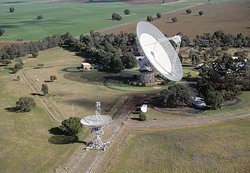Radio telescope
|
|
In contrast to an "ordinary" telescope, which produces visible light images, a radio telescope "sees" radio waves emitted by radio sources, typically by means of a large parabolic ("dish") antenna, or arrays of them. The first of these was the 9m telescope constructed by Grote Reber in 1937. In the early 1950s the Cambridge Interferometer mapped the radio sky to produce the famous 2C and 3C surveys of radio sources. In the late 1950s and early 1960s the largest single-dish radio telescope in the world was the 76 metre telescope at Jodrell Bank, which became operational in 1957. This was just the latest of many radio telescopes constructed during the middle of the 20th Century, and has been surpassed by more modern telescopes and arrays of telescopes.
The largest individual radio telescope is the RATAN-600 (http://www.sao.ru/ratan/) (Russia) with 576 metre diameter of circular antenna (RATAN-600 description (http://www.sao.ru/ratan/technic/desc.html.en)). The largest radio telescope in Europe is the 100 metre diameter antenna in Effelsberg, Germany, which also was the largest fully steerable telecope for 30 years until the Green Bank Telescope was opened in 2000. The largest radio telescope in the United States until 1998 was Ohio State University's The Big Ear. A typical size of the single antenna of a radio telescope is 25 metre, dozens of radio telescopes with comparable sizes are operated in radio observatories all over the world.
The best-known (although non-steerable) radio telescope probably is the Arecibo radio telescope located in Arecibo, Puerto Rico.
USA.NM.VeryLargeArray.02.jpg
Another well-known radio telescope is the Very Large Array (VLA), in Socorro, New Mexico. This telescope consists of an interferometric array formed from several receivers. The largest exisiting radio telescope array is the GMRT. A larger array, the 'LOw Frequency ARray' is currently being constructed in western Europe, consisting of 25000 small antennas over an area of several 100s of kilometres in diameter.
The sub-field of astronomy related to observations made through radio telescopes is known as radio astronomy.
Many celestial objects, such as pulsars or active galaxies (like quasars), produce radio-frequency radiation and so are best "visible" or even only visible in the radio region of electromagnetic spectrum. By examining the frequency, power and timing of radio emissions from these objects, astronomers can improve our understanding of the Universe.
Radio telescopes are also occasionally involved in SETI and tracking space probes (see Deep Space Network).
Related topics
- aperture synthesis
- Complete list of radio telescopes on Wikipedia
- Alternative, smaller list of radio telescopesde:Radioteleskop
eo:radioteleskopo fr:Radiotélescope it:Radiotelescopio nl:Radiotelescoop ja:電波望遠鏡 pl:Radioteleskop pt:Radiotelescópio simple:Radio telescope zh:射电望远镜

